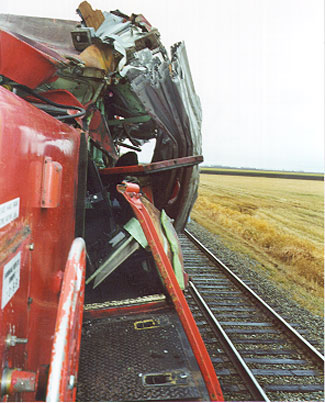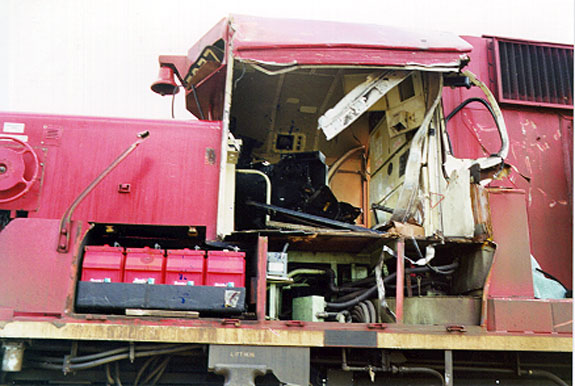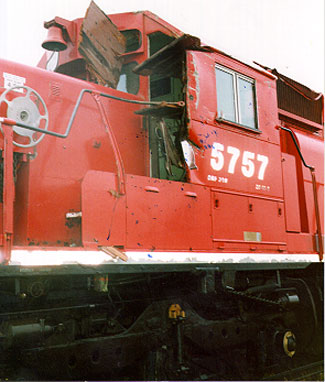Derailment and collision
Canadian Pacific Railway
train 472-30 and train 471-30
mile 42.4, Carberry subdivision
near Poplar Point, Manitoba
The Transportation Safety Board of Canada (TSB) investigated this occurrence for the purpose of advancing transportation safety. It is not the function of the Board to assign fault or determine civil or criminal liability. This report is not created for use in the context of legal, disciplinary or other proceedings. See Ownership and use of content. Masculine pronouns and position titles may be used to signify all genders to comply with the Canadian Transportation Accident Investigation and Safety Board Act (S.C. 1989, c. 3).
Summary
On 01 November 1999, at approximately 0735 Central standard time, Canadian Pacific Railway (CPR) intermodal freight train 471-30 (train 471), operating westward on the north main track of the CPR Carberry Subdivision, derailed two cars loaded with empty double-stacked containers. The derailed cars remained upright, though leaning towards the south main track. At approximately Mile 42.4, eastward CPR intermodal freight train 472-30 (train 472), passing on the south main track, collided with the top containers on the derailed cars. The three locomotives and a container on train 472 were damaged. Six of eight containers that were loaded on the two derailed cars from train 471 were also damaged. No one was seriously injured and no dangerous goods were involved.
Ce rapport est également disponible en français.
Factual Information
On the morning of 01 November 1999, intermodal freight train 471, largely made up of well-type container flat cars loaded with double-stacked containers,Footnote 1 was operating westward on the north main track of the Carberry Subdivision en route from Winnipeg to Brandon, Manitoba. On the same morning, intermodal freight train 472, also largely made up of well-type container flat cars loaded with double-stacked containers, was operating eastward on the south main track.
At approximately 0735 Central standard time (CST),Footnote 2 train 471 met train 472 near Mile 42.4. When the locomotive consists of the two trains had passed each other by approximately 20 car lengths, the crew on train 472 observed that train 471 had derailed cars mid-train and that containers on the derailed cars were leaning towards the track on which train 472 was operating.
The locomotive engineer on train 472 applied the train brakes in emergency as the conductor made a radio call to advise the crew of train 471 that their train (train 471) had derailed. Anticipating an impact, the crew of train 472 took cover on the floor in the area between the locomotive engineer's seat and the rear door exiting the locomotive cab. The conductor and locomotive engineer were covered with broken glass and sought medical attention to remove the shards from their hair. The conductor sustained minor bruising.
While stopping in emergency, the three locomotives on train 472 struck the top containers loaded on derailed car DTTX 723489.
Shortly after hearing the radio call from train 472, the crew of train 471 experienced a train-initiated emergency brake application. The conductor on train 471 immediately made an emergency radio broadcast and reported to the rail traffic controller (RTC) that the train had derailed and was stopped in emergency. The crew members on train 471 also reported to the RTC that they had lost radio communication with train 472.
Once stopped, the crew of train 472 attempted to make an emergency radio broadcast using the locomotive radio. However, the locomotive radio was not functioning. The conductor subsequently located the portable radio and was able to re-establish communication with the crew of train 471.
Following the collision, the conductor of train 471 assessed the condition of train 471 while walking back to the location of the locomotives of train 472. There, the conductor of train 471 encountered the conductor and locomotive engineer of train 472, and the three crew members continued to assess the condition of the two trains.
Damage to the two trains was as follows:
The three SD-40-2 locomotives on train 472 sustained extensive damage. However, the locomotives did not derail. The conductor's side of the lead locomotive on train 472, CP 5921, was raked open and the metal skin peeled back the length of the locomotive cab. The locomotive windshield and side windows were broken and the locomotive cab roof was buckled inward. The front door on the conductor's side was catapulted into the conductor's seat (see Figure 1).
The second locomotive on train 472, CP 5877, was similarly raked open on the conductor's side and the metal skin peeled back exposing the locomotive batteries and the interior of the locomotive cab (see Figure 2). The conductor's seat was torn from its mount and was located approximately 400 feet away from the locomotive, laying on the ballast between the two main tracks.
The cab of the third locomotive on train 472, CP 5757, was penetrated through the windshield and conductor's side door by large, splintered pieces of plywood from containers that were breaking up at the time of contact with the third locomotive (see Figure 3).
The bottom container loaded on car DTTX 025317, the 27th car behind the locomotives in the consist of train 472, was also raked open by a piece of metal from the shattering containers on train 471. As a consequence, some of the lading--cartons of toys--were ripped out of the container and strewn along the track. A number of containers on cars between the locomotives and car DTTX 025317 received minor scrapes and dents.
On train 471, two cars derailed and six containers were damaged, in some cases destroyed. The derailed cars were as follows:
- car DTTX 723489__a three-platform, articulated, well-type container flat car__all three platforms of which had been loaded with empty double-stacked containers; and
- car DTTX 454021__a single-platform, well-type container flat car which had also been loaded with empty double-stacked containers.
In the direction of travel, car DTTX 723489 had been marshalled immediately ahead of car DTTX 454021. Car DTTX 723489, with the "B" platform leading, derailed trucks B, D, and A to the field side of the north track. The leading, "B" end truck of car DTTX 454021 also derailed to the field side of the north track.
Car DTTX 723489 had been built in May 1999; car DTTX 454021, in 1995. Neither car showed signs of component wear or defects when inspected after the accident.
Train 472 was approximately 4 960 feet long, with a gross weight of approximately 4 970 tons. It was powered by 3 locomotives handling 35 loaded cars.
Train 471 was approximately 5 990 feet long, with a gross weight of approximately 5 560 tons. It was powered by 3 locomotives and was handling 3 additional locomotives and 34 loaded cars.
Many types of trains, including intermodal trains handling flat cars loaded with double-stacked containers, have a natural tendency to oscillate when in transit. Accordingly, container flat cars, and others, are designed and built with elements, such as constant contact side bearings, to minimize natural oscillation.
The crews of trains 471 and 472 each comprised a conductor and a locomotive engineer. All four crew members were familiar with the territory and were qualified for their respective positions.
The conductor and locomotive engineer on train 471 had experienced nothing unusual in the operation or handling of their train before the accident (except that they were unable to attain maximum authorized track speed). They attributed their inability to gain the maximum speed to the unusually high wind conditions. They also experienced difficulty walking in the wind in the aftermath of the accident.
Traffic on the Carberry Subdivision main track from approximately Mile 5.8 near Woodman, Manitoba, to approximately Mile 53.7, Tucker, Manitoba, is governed by the Automatic Block Signal System and the Occupancy Control System of the Canadian Rail Operating Rules. Rail traffic is supervised by an RTC located in Calgary.
According to the time table in effect at the time of the accident, CP Lakes District Time Table 64, the maximum zone speed on the main track between Mile 5.8 and Mile 50.7 of the Carberry Subdivision was 60 mph for all trains.
Event recorder data from trains 471 and 472 indicated that, in the minutes leading up to the accident, both trains were travelling at speeds below the authorized maximum and were being operated in maximum throttle position No. 8. Train 471 was travelling at approximately 34 mph at the time of the train-initiated emergency brake application; train 472, at approximately 46 mph at the time of the operator-initiated emergency brake application. Event recorder data, otherwise, showed nothing unusual in the operation or handling of the trains.
Two main tracks are in the area of the accident. The rail is 115-pound continuous welded rail set on wood ties and crushed rock ballast. The terrain is flat, open prairie, and the track is tangent.
Track geometry car testing of the track in the accident area was conducted on 14 September 1999. No exceptions to CPR track maintenance standards were recorded. On the day of the accident, track geometry measurements were again taken which indicated that the track met CPR track maintenance standards, including cross-level and gauge requirements.
At Mile 42.15, wheel flange marks were observed on the ties, but not on the top of the rail. The wheel flange marks continued on the ties from Mile 42.15, westward to where the derailed cars came to rest at approximately Mile 42.4.
The weather on the morning of 01 November 1999 was a mix of rain and snow with high winds. Between 0700 and 0800, in the vicinity of Portage la Prairie, Manitoba, approximately 23 km from the accident location, Environment Canada recorded wind speeds between 67 and 83 km/h from the north-west, with gusts up to 107 km/h.
CPR had no requirement for weather information to be conveyed to operating crews. The issue of high cross-winds adversely affecting the safe operation of intermodal trains handling cars loaded with double-stacked containers did not appear in company train operating directives.
Standards for the crashworthiness of locomotives used on North American railways are contained in the Association of American Railroads (AAR) standard S-580 (adopted in 1989; revised in 1994 and in 1999). The standard presently requires that locomotives be equipped with two collision posts in the front end of the short hood of the locomotive. The collision posts must sustain impacts both at, and 30 inches (76.2 cm) above, the locomotive lower deck. This requirement is designed to mitigate the risk of cab crush resulting from a head-on collision with an object at track level and applies to the approximately 3 200 locomotives currently in service in Canada.
The standard does not address the possibility of cab crush or cab intrusion resulting from impact with an object above the height of the collision posts in the short hood of the locomotive. The AAR is aware of this omission and standard S-580 is currently being reviewed by a Railroad Safety Advisory Committee Working Group made up of representatives of the AAR, railway labour, locomotive manufacturers, and the Federal Railroad Administration.
The goal of the working group is to develop enhanced locomotive crashworthiness requirements that will mitigate the effects of collisions and minimize the potential for injury to train crews and others. The enhancements being considered are to be applicable to locomotives built after 01 January 2003. They include requirements for cab corner and centre posts, as well as improvements to window glazing and window structure. Locomotives built before 01 January 2003 will not be required to be updated.
The TSB Engineering Branch conducted a theoretical analysis (LP 102/00) to determine the wind speed necessary to cause wheel lift or car roll-over on both empty and loaded double-stacked, three-platform, well-type container flat cars. The TSB Engineering Branch concluded the following:
- A wind speed of 132 km/h (83 mph) blowing from a sideward direction to the train could topple cars loaded with empty containers, and a wind speed of 203 km/h (127 mph) is required if the containers are fully loaded.
- The dynamic forces on the cars due to the normal motion of the train, when superimposed on the known maximum wind speed (107 km/h or 66 mph), are considered to have been sufficient to have pushed the cars over on the day of the accident.
Many of the 1 432 000Footnote 3 containers shipped on Canadian trackage in 1999 were transported on double-stacked container cars. The number of containers shipped increased by 50 per cent in the last five years.Footnote 4 No other derailments recorded in the TSB database can be attributed to wind conditions.
Analysis
Event recorder data and statements from the operating crews were mutually supportive, indicating nothing unusual in train operation or train handling in the time leading up to the accident. Likewise, there was no indication that either track or equipment-related deficiencies had played a role. Track geometry measurements taken before and after the accident demonstrated no exceptions to track standards in the vicinity of the derailment; the derailed cars showed no signs of wear or defect. The only exceptional factor present was wind conditions.
The flange marks on the ties at Mile 42.15, without matching rail marking, are indicative of a wheel lift derailment at that location. As outlined by the TSB Engineering Branch report conclusions, the high winds (107 km/h), blowing from a sideward direction to train 471, combined with the normal oscillations of the moving cars, precipitated a wheel lift and the subsequent derailment of car DTTX 723489 and car DTTX 454021 at Mile 42.14.
The crews of trains 471 and 472 had noticed the high wind conditions, but they had not experienced any safety performance problems on their trains in the time leading up to the accident. The risk of high cross-winds affecting double-stacked intermodal cars was considered low, and there were no procedures in place to govern operations in these conditions. The company did not apparently appreciate that high cross-winds could be a problem for the safe operation of intermodal trains handling empty double-stacked containers. Such an event was demonstrated by the circumstances of this accident.
The conductor and locomotive engineer on train 472 reacted in a timely manner to the oncoming derailed cars and sought cover on the side of the locomotive cab opposite where the impact with the listing containers was anticipated. By doing so, they averted serious injury.
The damage to the three locomotive cabs was extensive considering the relatively light mass of the items striking them. While it is appreciated that accident impact damage to locomotive bodies commonly occurs to the collision-protected areas below the cab, this accident has demonstrated that, in some situations, locomotive cabs can be subjected to significant impact. It is apparent therefore that improved AAR locomotive cab strength and safety feature specifications, projected to be a requirement for locomotives built in 2003 and beyond, are warranted and will enhance safety. However, it will take a considerable time for the full safety benefits to be realized. Because of the long service life of locomotives in North America (20 to 40 years), a significant number of less well-protected units will remain in road service for many years, with a commensurate higher safety risk to operating crew members.
Findings
Findings as to causes and contributing factors
- The high cross-winds exaggerated the natural oscillation of the well cars loaded with empty double-stacked containers, causing wheel lift and the subsequent derailment of cars DTTX 723489 and DTTX 454021 at Mile 42.15.
Other Findings
- The risk of high cross-winds affecting double-stacked intermodal cars was considered low, and there were no procedures in place to govern operations in these conditions.
- The crew of train 472 averted serious injury by quickly seeking cover on the floor of the locomotive cab.
- Cab protection improvements will reduce the risk of cab crush or cab intrusion for locomotives built after 2003, but will not address the risk to crews operating units built before that time.
Safety Action
Safety action taken
CPR undertook a detailed study of available wind monitoring and assessment systems as some U.S. railways had developed algorithms that identify "blow-over speed" thresholds for various cars. The company reviewed more that 20 years of internal accident records which indicated very few instances where high winds were a contributing or causal factor in an accident. CPR also analysed 50 years of Environment Canada wind data gathered from selected sites near the derailment location and concluded that the installation of wind monitoring equipment at any given location on the CPR system would not be cost effective.
As of April 2000, CPR added high winds as an alert condition to its regular monitoring of weather advisories from Environment Canada and the Special Weather Alert service of the World Weather Watch (WWW). When the railway's Network Management Centre receives such an alert, the possible local impacts and action required are discussed with the service area managers.
Transport Canada (TC) intends to discuss the issue of the safety risk to railway operations posed by strong winds during its next semi-annual meeting with CPR. TC's approach will be to determine the extent of the problem and take action to prevent recurrence. Additionally, TC proposes to raise the issue with the Railway Research Advisory Board of the Railway Association of Canada.
This report concludes the Transportation Safety Board's investigation into this occurrence. Consequently, the Board authorized the release of this report on .


